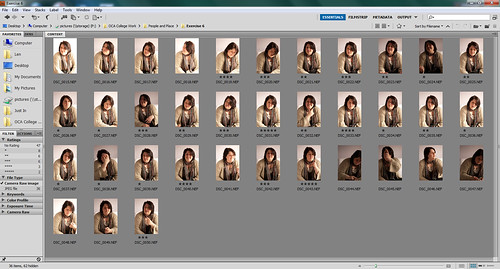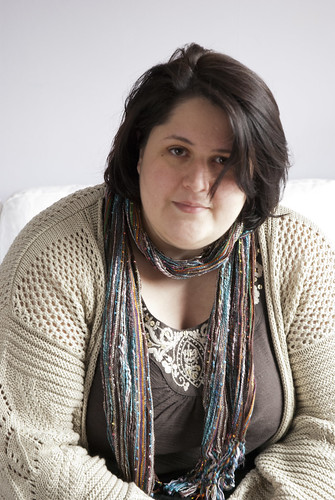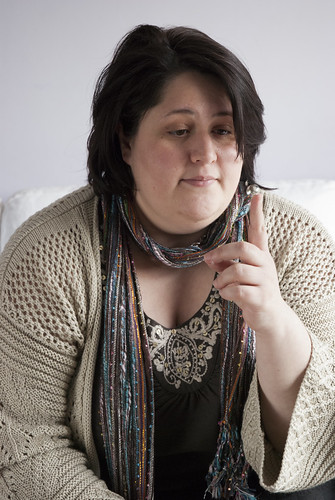Where: At home, Indoors
When: In the afternoon, just after about 2.pm. when the sun was high enough in the sky to provide light into the room but not directly and it was cloudy enough that the light was diffused.
How: I used the same setup for Ali as I did for Mark. The daylight from camera right was diffused by the clouds before passing through the window and was then bounced back using a white deflector for fill light.
I positioned Ali sitting on the sofa and then adjusted the reflector and camera position until I was happy with the position and the amount of reflected light. I practiced giving directions to Ali, who having observed Mark in the previous exercise was much more ‘up to speed’ and confident at receiving instructions.
As I took each shot I gave a graded score between 1 and 5 for each one into a digital voice recorder. This allowed me to concentrate on getting Ali to listen and respond to my directions. I was hoping to keep Ali on the same position on the sofa and just adjust her expression and eye line, but I found that after 16 photos that she wanted to change position completely which meant that I had to readjust the camera position and the reflector and start again.
From time to time Ali would show the same psychological reaction to the camera shutter as Mark and would put on her “photo face”. I had then to stop and direct her before starting to shoot again. Ali responded well to the instructions and had a lot of fun playing for the camera.
After the session, I looked over the images on the camera screen and removed duplicate images where I had pressed the remote release too hard and had taken more than one photo. I then reviewed the images against the scores on the digital recorder to ensure that they matched.
My next step was to review the Jpeg version of the images on a large TV screen to get an idea of how they looked and allow Ali to see what we had been doing. I followed this up by properly reviewing the RAW images on a PC screen using Adobe Bridge allowing for white balance colour correction, looking at each individual image on its own and giving each image a score between 1 and 5 stars. I have prepared a screenshot showing a screen of the full set of images as shown in Bridge with their relevant star score.
Screenshot of Adobe bridge with scores given on review.

I compared these scores to the scores I had given during the session. In many cases the score differed; some which looked good on the camera screen were not as good when displayed in either the RAW or Jpeg format on a larger screen. I was pleasantly surprised to find a number where my score matched or was bettered on review on the larger screen.
Matched Score 4/5
DSC_0031
Nikon D80, focal length 52.0mm (35mm equivalent 78mm), aperture f4.5, speed 1/30 second, ISO 500, Shade white balance, Spot metering, tripod mounted camera, 17-70mm lens, No flash.

As soon as I felt that Ali was sitting in the right position with the right expression I took this shot and install marked it with a high score as I felt at that moment I had nailed a perfect image of Ali.
Surprise Match 2/5
DSC_0043
Nikon D80, focal length 52.0mm (35mm equivalent 78mm), aperture f4.4, speed 1/45 second, ISO 500, Shade white balance, Spot metering, tripod mounted camera, 17-70mm lens, No flash.

I was surprised by this as this was one of the last shots we did and I blew a couple of plastic bubbles into the air just for fun so that Ali could see that these bubbles did not burst when touched. Ali of course being a scientist was amused to see such a thing. I thought that the shot I took looked pretty poor and that her eyes were too shaded and her expression was one of boredom, however on review I was pleased to find that I really liked Alis’ expression and that fact that her eye line was off camera as she was focussing completely on the bubble.
Low Score all round 1/1
DSC_0026
Nikon D80, focal length 50.0mm (35mm equivalent 75mm), aperture f4.5, speed 1/45 second, ISO 500, Shade white balance, Spot metering, tripod mounted camera, 17-70mm lens, No flash.

Just as I pressed the shutter release, Mark said something which made Ali suddenly change her expression. I was not happy with this image as soon as I shot it and gave it a low score, on review I was tempted to mark it down to Zero and discard the image entirely but felt that it should stay as a 1. Ali’s expression is not pleasing and with her looking off camera it just looks as if someone has been rude to her.
Low Score on review 3/1
DSC_0036
Nikon D80, focal length 50.0mm (35mm equivalent 75mm), aperture f4.5, speed 1/30 second, ISO 500, Shade white balance, Spot metering, tripod mounted camera, 17-70mm lens, No flash.

On shooting this I gave it a mid range score, on review however I just did not like the image and marked it down accordingly.
The overall result on this exercise was not a great surprise to me as I had found on previous occasions that the smaller screen failed to show small movement blur and shadow definition.
I decided to upload the images, taken without looking through the eyepiece, where the scores either matched or showed the greatest difference.
I also find that as the camera is not a full frame sensor and the way the camera has been designed that the image presented in the eyepiece is only about 90% of what is actually captured within the frame I try not to rely on the back of the camera, preferring to stop and review the images on either a larger screen (such as a monitor or large screen TV) or on a laptop screen usually using my instant judgement on taking the shot whether I think that it is usable or not.
I try not to “chimp” and examine each image immediately after shooting it as I think this is a waste of time and opportunity.
Where I can, I prefer to shoot portraits where the camera is tethered to a PC or a laptop so that I can instantly see what the image looks like for review and re-shoot purposes. I try to ensure that the TV/PC/Laptop screen is colour managed normally using a colour management tool like a Spider so that I know that the colours shown on the screens not only are the same on each screen I use but they are closer to the final image colours than those displayed on a small camera LCD screen.
No comments:
Post a Comment